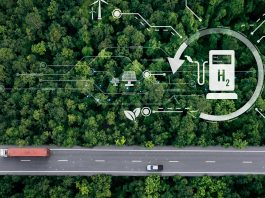Green hydrogen is a zero-emission fuel produced through water electrolysis using renewable power sources. It has the potential to decarbonise industries dependent on fossil fuels, making it a critical component of the energy transition.
Green hydrogen is gaining attention for its ability to store and transport renewable electricity as the demand for sustainable energy solutions grows. Unlike other forms of hydrogen, its production does not involve fossil fuels, making it an environmentally viable option.
Jack Shaw, writer and editor at Modded, explores the technical processes involved in green hydrogen production, from electrolysis and energy sourcing to storage and scalability.
What is green hydrogen?
Green hydrogen is produced through the process of water electrolysis using electricity generated from renewable sources such as wind, solar or hydropower. Unlike hydrogen produced from fossil fuels, which releases carbon dioxide into the atmosphere, green hydrogen is considered a clean, sustainable alternative because its production results in zero direct emissions.
In the context of energy transition, it plays a vital role in decarbonising sectors that are difficult to electrify directly, like long-haul transportation and power storage. When produced at scale, it has the potential to serve as a clean fuel for power generation, a feedstock for chemicals and an alternative to fossil fuels in transportation.
The importance of green hydrogen lies in its versatility and its ability to store excess renewable energy, helping to mitigate issues associated with renewable power sources like solar and wind.
Converting surplus renewable electricity into hydrogen allows this form of energy to be stored for later use, transported and even integrated into existing infrastructure, making it a crucial part of a future sustainable system.
Electrolysis: The core process
Electrolysis is the primary method for producing green hydrogen, involving the splitting of water into hydrogen and oxygen using electricity. An electric current is passed through water, which contains an electrolyte — often a dilute acid or base — to facilitate the flow of ions. The electric current causes the water molecules to break apart, producing hydrogen gas at the cathode and oxygen gas at the anode.
The efficiency and cost-effectiveness of green hydrogen production depend significantly on the type of electrolyser used. There are three main types: alkaline, proton exchange membrane and solid oxide. Each of these technologies offers distinct advantages and challenges in terms of efficiency, scalability and cost.
These electrolyser options are advancing in terms of performance, cost and scalability, but all rely on a critical factor for success: the availability of low-cost renewable electricity. The price of hydrogen production is directly tied to the price of green energy, making the cost reduction of electrolysers and renewable power a key focus for the growth of the green hydrogen sector.
Powering electrolysis: The renewable energy link
Green hydrogen production relies heavily on renewable energy sources, such as wind, solar and hydropower, to power the electrolysis process. The electricity used in electrolysis must come from clean, sustainable sources to maintain the environmental benefits of green hydrogen. Renewables play a dual role by powering electrolysis and mitigating the intermittency issues associated with wind and solar power.
Integrating renewable power with electrolysis can be difficult due to the variability of these sources. For example, solar and wind energy are intermittent, meaning energy production does not always align with the demand for hydrogen. To address this, storage solutions like battery systems or excess renewable energy generation during peak production periods are essential to ensure a stable supply of electricity for electrolysis.
While renewable energy prices have fallen in recent years, the cost of green hydrogen production still depends largely on the cost and availability of electricity. Continued advancements in power storage, grid integration and renewable energy efficiency are key to making green hydrogen more economically viable.
Water supply and purification
Electrolysis requires a steady and reliable supply of water, with deionised or purified liquid being the ideal input. Water quality directly impacts the efficiency of the electrolysis process, as impurities can damage the electrolyser components. In some cases, seawater can be used, but it requires additional desalination and purification, which adds cost and complexity.
Water consumption in large-scale green hydrogen production can be significant, raising concerns in water-scarce regions. Therefore, ensuring a sustainable and efficient supply is critical.
Technologies for using brine from desalination or improving recycling systems are emerging to address these challenges, but they must be balanced with the overall environmental impact of water use in hydrogen production.
Compression, storage and transport
Once green hydrogen has been produced, it must be compressed, stored and transported for use. Hydrogen is a low-density gas, so compressing or liquifying it makes it easier to store and transport. Compression is typically done to 700 bar for gaseous hydrogen.
Storage options include high-pressure tanks, underground storage caverns or liquified hydrogen. Transporting hydrogen can be done via pipelines or, in regions without existing infrastructure, by trucks or ships. One emerging solution is transporting hydrogen as ammonia, which can be more easily stored and shipped before being converted back to hydrogen at the destination.
The infrastructure for hydrogen storage and transport is still developing. Scaling these systems to meet demand is essential to enabling widespread green hydrogen use, particularly in industries and regions that are far from production sites.
Challenges and innovations
Scaling up green hydrogen production faces several challenges, primarily related to cost, efficiency and infrastructure. Currently, the production of green hydrogen remains more expensive compared to hydrogen produced from fossil fuels due to the high costs of electrolysers and renewable electricity. However, technological advancements and economies of scale are expected to drive down these expenses over time.
Innovation is focused on improving electrolyser efficiency, developing cheaper materials and enhancing renewable energy integration. There is also a growing interest in increasing the use of low-cost, abundant renewable energy sources like offshore wind and solar farms in regions with high green power potential. Additionally, governments and private sectors are investing in hydrogen infrastructure, such as pipelines and storage systems, to enable more widespread adoption.
Addressing these challenges requires coordinated efforts across the supply chain, including policy support, technological development and market incentives to make hydrogen competitive with traditional fuels.
As these innovations come to life, the path toward large-scale green hydrogen production and its integration into the global energy system becomes increasingly viable.
Fuelling the future
Green hydrogen holds significant potential to transform the energy landscape, offering a sustainable, zero-emission solution for industries that are difficult to decarbonise. While challenges remain in scaling up production, advancements in electrolyser technologies, renewable power integration and storage solutions are paving the way for its widespread use.
Strong policy support, government incentives and private sector investment are accelerating research and infrastructure development, making green hydrogen more competitive. Beyond energy and transportation, industries such as steel production, chemicals and aviation are beginning to explore its potential.
As innovation continues and costs decrease, green hydrogen is poised to play a pivotal role in achieving global sustainability goals. The future of energy may very well be powered by the hydrogen atom — clean, green and ready to fuel progress.









